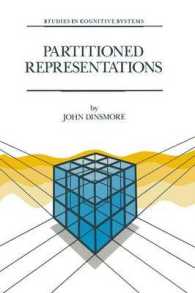- ホーム
- > 洋書
- > 英文書
- > Architecture
基本説明
New in paperback. Hardcover was published in 1994. Describes a series of different visual and mental models by which the urban environment has been recognized, depicted, and planned.
Full Description
This work faces the crisis of the city in the late 20th century, embarking on a journey through theatres and museums, panoramas and maps, buildings and institutions that are used to construct a new reading of the city as a system of representation. Boyer brings together elements and concepts from geography, critical theory, architecture, literature and painting in a synthetic and readable work that is broad in its reach and original in its insights. What emerges is a sense of the city reinvigorated with richness and potential. This book describes a series of different visual and mental models by which the urban environment has been recognized, depicted and planned. Boyer identifies three major "maps": one common to the traditional city - the city as a work of art; one characteristic of the modern city - the city as panorama, and one appropriate to the contemporary city - the city as spectacle. This illustrated and documented study pays considerable attention to the normally hidden and unspoken codes that regulate the order imposed on and derived from the city. A wide range of secondary historical literature and theoretical work is considered, with evident debts to structuralist analysis of urban form represented bv Aldo Rossi, as well to post-structuralist criticism from Walter Benjamin to the present.
Contents
The place of history and memory in the contemporary city; city images and representational forms. Part 1 Historical precedents for the city of collective memory: the city and the theatre; the art of collective memory; topographical travelogues and city views; invented traditions and cityscapes. Part 2 Contemporary forms of the city of collective memory: the instruments of memory; Manhattan montage. Epilogue: the city as radical artifice.








